9.3: Introducing the Foundations
Introducing the Foundations
The California preschool learning foundations for math have been divided into five broad areas or strands.
- Number Sense
- Algebra and Functions (Classification and Patterning)
- Measurement
- Geometry
- Mathematical Reasoning[1]
Supporting Number Sense
The Number Sense strand refers to concepts of numbers and their relationships. It includes the development of counting skills, the understanding of quantities, recognizing ordering relations (which has more, fewer, or less), part-whole relationships, and a basic understanding of “adding to“ and “taking away” operations.

| 1.0 Children begin to understand numbers and quantities in their everyday environment. | 1.0 Children expand their understanding of numbers and quantities in their everyday environment. |
| 1.1 Recite numbers in order to ten with increasing accuracy. | 1.1 Recite numbers in order to twenty with increasing accuracy. |
| 1.2 Begin to recognize and name a few written numerals. | 1.2 Recognize and know the name of some written numerals. |
| 1.3 Identify, without counting, the number of objects in a collection of up to three objects (i.e., subitize). | 1.3 Identify, without counting, the number of objects in a collection of u to four objects (i.e., subitize). |
| 1.4 Count up to five objects, using one-to-one correspondence (one object for each number word) with increasing accuracy. | 1.4 Count up to ten objects, using one-to-one correspondence (one object for each number word) with increasing accuracy. |
| 1.5 Use the number name of the last object counted to answer the question, “How many . . . ?” | 1.5 Understand, when counting, that the number name of the last object counted represents the total number of objects in the group (i.e., cardinality). |
| 2.0 Children begin to understand number relationships and operations in their everyday environment. | 2.0 Children expand their understanding of number relationships and operations in their everyday environment. |
| 2.1 Compare visually (with or without counting) two groups of objects that are obviously equal or nonequal and communicate, “more” or “same.” | 2.1 Compare, by counting or matching, two groups of up to five objects and communicate, “more,” “same as,” or “fewer” (or “less”). |
| 2.2 Understand that adding to (or taking away) one or more objects from a group will increase (or decrease) the number or objects in the group. | 2.2 Understand that adding one or taking away one changes the number in a small group of objects by exactly one. |
| At around 48 months of age | At around 60 months of age |
| 2.3 Understand that putting two groups of objects together will make a bigger group. | 2.3 Understand that putting two groups of objects together will make a bigger group and that a group of objects can be taken apart into smaller groups. |
| 2.4 Solve simple addition and subtraction problems nonverbally (and often verbally) with a very small number of objects (sums up to 4 or 5). | 2.4 Solve simple addition and subtraction problems with a small number of objects (sums up to 10), usually by counting. |
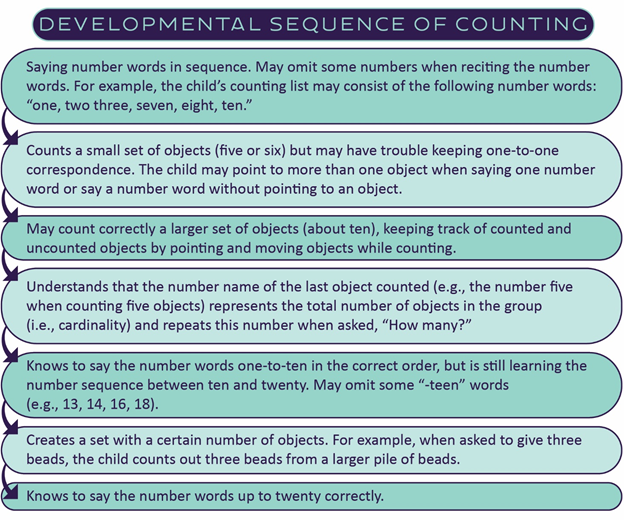
Teachers can support children’s development of the number sense foundations with the following:
- Observe children’s spontaneous counting and foster growth through scaffolding or modeling
- Encourage counting during everyday interactions and routines
- Include preschool children’s home language in counting activities, whenever possible
- Ask questions that encourage purposeful counting
- Foster one-to-one correspondence within the context of daily routines (such as setting the table)
- Support preschool children’s ability to apply the counting procedure by
- Providing a lot of objects to count
- Starting with small sets
- Modeling counting
- Encouraging children to self-correct their counts
- Consider adaptations for children with special needs
- Use games, books, and other materials accessible to preschool children
- Plan group activities focused on counting
- Promote the use of comparison terms (more, same as, fewer, or less) through everyday interactions
- Use everyday interactions and routines to illustrate and discuss addition and subtraction transformations (“adding to” results in more and “taking away” results in less)
- Make estimations
- Use graphing with children[2]
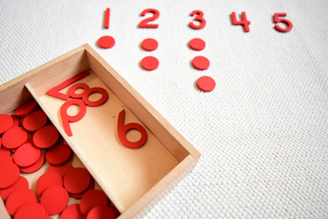
Vignettes
Playing with cars on the rug, a child argued, “I have more: one, two, three, seven, nine, ten.” His friend replied, “No, I have more: one, two, three, four, five, six, seven.” The teacher intervened and asked, “How do you think we can find out who has more cars?” “I count,” said one of the children. The teacher suggested, “Let’s count together,” and she modeled counting together with the children. She put the cars in each set, in a row, and lined up the two sets against each other. The teacher pointed to each car while counting.
During snack time, Veronica asked: “Can I have two more crackers?” The teacher replied, “Yes, and I see you already have two crackers. When I give you two more, how many crackers will you have altogether?”[3]
Supporting Algebra and Functions (Classification and Patterning)
Obviously, preschool is not the time to teach traditional algebra, but this is the period when foundational algebraic concepts evolve and gradually develop. Children observe the environment and learn to recognize similarities and differences. They learn to sort, group, and classify objects. They learn to recognize ordering relations, such as large to small, and to identify patterns. They develop the ability to make predictions, form generalizations, and derive rules.
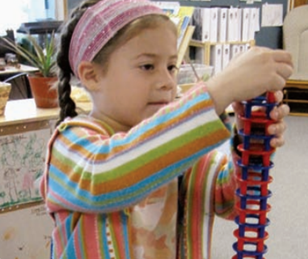
| At around 48 months of age | At around 60 months of age |
| 1.0 Children begin to sort and classify objects in their everyday environment. | 1.0 Children expand their understanding of sorting and classifying objects in their everyday environment. |
| 1.1 Sort and classify objects by one attribute into two or more groups, with increasing accuracy. | 1.1 Sort and classify objects by one or more attributes, into two or more groups, with increasing accuracy (e.g., may sort first by one attribute and then by another attribute). |
| 2.0 Children begin to recognize simple, repeating patterns. | 2.0 Children expand their understanding of simple, repeating patterns. |
| 2.1 Begin to identify or recognize a simple repeating pattern. | 2.1 Recognize and duplicate simple repeating patterns. |
| 2.2 Attempt to create a simple repeating pattern or participate in making one. | 2.2 Begin to extend and create simple repeating patterns. |
Teachers can support children’s development of the algebra and functions foundations with the following:
- Organize the classroom into different categorized storage areas to facilitate classification
- Include materials and objects for sorting in the environment
- Identify opportunities for sorting and classifying in everyday routines
- Recognize and extend sorting in play
- Plan for children at different levels
- Integrate sorting into children’s current topic of interest and study
- Point out patterns in the environment
- Engage preschool children in conversations about patterns
- Play with patterns in various formats such as
- Objects
- Movement
- Sounds
- Rhymes and stories[4]

Vignettes
As part of a curriculum unit on the seasons, the children went for a nature walk and collected various types of leaves. During the walk and later in the classroom, the children explored the leaves and were encouraged to describe different attributes of the leaves such as shape (pointy, round, long, needle), size (small, tiny, wide, big), color (red, green, yellow, orange, brown) and texture (smooth, soft, hard, wet, dry, rough). Children were then asked by the teacher to sort the leaves: “Put leaves that belong together in groups.”
The teacher asks Enrique, “Why did you put these leaves together and those leaves together?” Enrique responds, “They are same.” The teacher asks, “How are these the same?” Enrique points and says in Spanish, “Café aquí, amarillo aquí, y hojas rojas.” (“Brown here, yellow, here, and red leaves here.”). The teacher points to each group of leaves and says in English, “Great! Brown, yellow, and red leaves. What other ways can we sort the leaves? How about putting all the big leaves here and all the small ones there?” The teacher models for the child, sorting leaves by size. “Where do you think this leaf would go?”
Pause to Reflect
Before reading this section, did you think that algebra was something that should be considered in the preschool classroom? Why or why not?
Supporting Measurement
The Measurement strand involves comparing, ordering, and measuring things. Included in this strand is the child’s ability to compare and order objects by length, height, weight, or capacity; to use comparison vocabulary; and to begin to measure. Young children develop an intuitive notion of measurement through natural everyday experiences. They explore and discover properties such as length, height, volume, and weight as they look for a longer block, measure who is taller, pour sand from a small bucket to a larger one, or try to pick up a heavy box and ask for help. They make comparisons to see which is longer, taller, heavier, larger, or smaller.
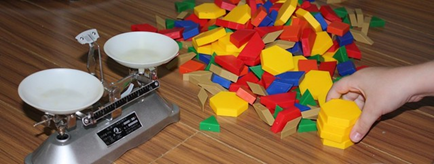
| At around 48 months of age | At around 60 months of age |
| 1.0 Children begin to compare and order objects. | 1.0 Children expand their understanding of comparing, ordering, and measuring objects. |
| 1.1 Demonstrate awareness that objects can be compared by length, weight, or capacity, by noting gross differences, using words such as bigger, longer, heavier, or taller, or by placing objects side by side to compare length. | 1.1 Compare two objects by length, weight, or capacity directly (e.g., putting objects side by side) or indirectly (e.g., using a third object). |
| 1.2 Order three objects by size. | 1.2 Order four or more objects by size. |
| This box intentionally left blank | 1.3 Measure length using multiple duplicates of the same-size concrete units laid end to end. |
Teachers can support children’s development of the measurement foundations with the following:
- Provide opportunities to promote measurement concepts in the environment (things to measure and measure tools)
- Observe preschool children’s measurement concepts in everyday play and routines
- Facilitate and reinforce measurement concepts in everyday play and routines by
- Building the descriptive and comparative vocabulary
- Asking questions to bring their attention to the measurable properties of objects
- Challenging them to use measurement to solve problems
- Provide opportunities to compare and order objects
- Use literature to illustrate measurement concepts
- Provide small-group activities using standard and nonstandard measurement
- Encourage estimations of measurement
- Encourage recording and documentation of measurements[5]
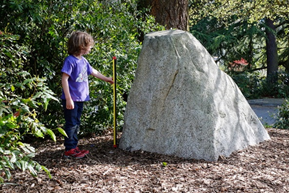
Vignettes
As part of exploring and learning the concept of growth, the children have planted sunflower seeds in the garden. A long stick was attached to each plant, and the teacher asked that every week the children mark on the stick the height of the sunflower. Tracking the growth of sunflowers has generated comparison and measurement experiences. For example, one week the teacher pointed to one of the sunflowers and explained to the children, “Last week when we measured this sunflower, it was up to here. It was seven inches long. This week it is up to here. How many more inches do you think it grew in the past week? What is your estimate?”
Children were encouraged to make estimates and then were invited to measure the growth of this sunflower. “How can we measure how much it has grown since last time?” Children had different ideas. Some children said, “You need a ruler.” Others said, “With this” and pointed to a measuring tape. Over time, children were also comparing the sunflowers one to another. On one occasion, the teacher helped a small group of children compare the height of two flowers by using a string to represent the height of one flower and then laying the string against the second flower.
Children enjoyed tracking the sunflowers’ growth and finding out, “Which sunflower is taller?” and “Which is taller?”—the child or the sunflower.[6]
Pause to Reflect
Involving children in measuring things that are meaningful to them is a great way to engage children in mathematics. Do you remember any measurements experiences from your childhood? This could be formal, like keeping track of your height on a wall or growth chart or measuring the weight and/or length of a fish caught or informal, such as recognizing that a new storage container holds more (volume) or noticing the length difference in a new pair of shoes.
Supporting Geometry
Geometry is the study of shapes and spatial relationships. Children enter preschool with a strong intuitive knowledge about shapes, spatial location, and transformations. They learn about geometry as they move in space and interact with objects in their environment. From infancy they begin to form shape concepts as they explore their environment, observe shapes, and play with different objects. Before they can name and define shapes, very young children are able to match and classify objects based on shape. During the preschool years, children develop a growing understanding of shape and spatial relationships. They learn the names of shapes and start to recognize the attributes of two- and three-dimensional shapes. They also develop an understanding of objects in relation to space, learning to describe an object’s location (e.g., on top, under), direction (e.g., from, up, down) and distance (e.g., near, far).
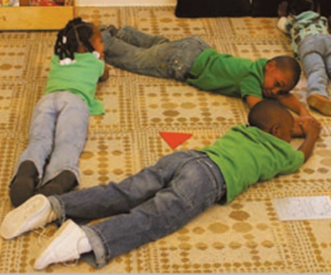
| At around 48 months of age | At around 60 months of age |
| 1.0 Children begin to identify and use common shapes in their everyday environment. | 1.0 Children identify and use a variety of shapes in their everyday environment. |
| 1.1 Identify simple two-dimensional shapes, such as a circle and square. | 1.1 Identify, describe, and construct a variety of different shapes, including variations of a circle, triangle, rectangle, square, and other shapes. |
| 1.2 Use individual shapes to represent different elements of a picture of design. | 1.2 Combine different shapes to create a picture or design. |
| 2.0 Children begin to understand positions in space. | 2.0 Children expand their understanding of positions in space. |
| 2.1 Identify positions of objects and people in space, such as in/on/under, up/down, and inside/outside. | 2.1 Identify positions of objects and people in space, including in/on/under, up/down, inside/outside, beside/between, and in front/behind. |
Teachers can support children’s development of the geometry foundations with the following:
- Refer to shapes and encourage the use of shape names in everyday interactions
- Engage preschool children in conversations about shapes, including both
- Two-dimensional shapes (such as circles, squares, and triangles)
- Three-dimensional shapes (such as spheres, cubes, and cones)
- Provide materials that encourage preschool children to explore and manipulate shapes in space
- Include books, games, and other learning materials with shape-related themes in the preschool environment
- Provide preschool children with playful opportunities to explore and represent shapes in a variety of ways
- Present preschool children with many different examples of a type of shape
- Provide materials and equipment to promote spatial sense
- Support preschool children’s spatial sense in everyday interactions
- Provide preschool children with planned experiences to promote the understanding of spatial sense, including
- Songs and games
- Books
- Construction opportunities[7]
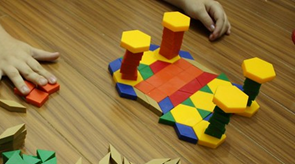
Vignettes
The teacher had noticed that several children in her group had shown a strong interest in castles. They built castles in the block area, in the sandbox, and even looked for castles in fairy tale books when visiting the library. The teacher suggested that the group build a big castle outside. They started by gathering the materials. The children brought from home different sized boxes and figures or characters to be included in the castle. The teacher also offered big cylinders, cones, building blocks, construction boards, and other materials. The children made different suggestions: “Put all the big boxes here and the small ones on top of them.” ”I put it above this for the roof.” “We can use these for the tower.”
The teacher described their ideas using names of shapes and spatial terms. “So you want to put the small square blocks on top of the big rectangle blocks.” “Are you suggesting using the cylinders to build the tower?” The children enjoyed building the structure, using different shapes and materials, and were proud of it.
During circle time, the teacher invited children to describe the castle and how it was built. “Look at the castle you built. Can you tell me what it looks like?” Children were encouraged to use spatial words and the names of shapes in their talk. The activity evolved into a long-term project. The children kept adding more pieces to the structure and added different elements to decorate the castle.[8]
Supporting Mathematical Reasoning
Mathematical reasoning is a key process in learning and developing mathematical knowledge in all areas of mathematics, including number and operations, classification, patterning, measurement, and geometry. It involves the ability to think and reason logically, to apply mathematical knowledge in different problem-solving situations, and to come up with different solutions. Mathematical reasoning is natural to most young children as they explore the environment and make sense of the world around them.
| At around 48 months of age | At around 60 months of age |
| 1.0 Children use mathematical thinking to solve problems that arise in their everyday environment. | 1.0 Children expand the use of mathematical thinking to solve problems that arise in their everyday environment. |
| 1.1 Begin to apply simple mathematical strategies to solve problems in their environment. | 1.1 Identify and apply a variety of mathematical strategies to solve problems in their environment. |
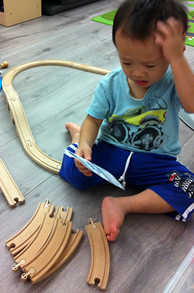
Teachers can support children’s development of the mathematical reasoning foundations with the following:
- Identify and create opportunities for mathematical reasoning through both spontaneous interactions and planned experiences
- Pose meaningful questions that promote investigation and inquiry and challenge children to think through a problem and come up with a solution
- Support preschool children in reasoning mathematically by providing clues, encouragement, and modeling, as needed[9]
Vignettes
The children cleaned up the play yard before going back inside. The teacher, Ms. Denise, had noticed that not all the shovels were picked up from the sandbox. Ms. Denise asked for help saying, “We need all five shovels back in the box so our toys aren’t lost. I see here only three. We need more shovels in the box. How many more shovels do we need?” The teacher had noticed that Ling Wa, one of the older preschool children in the group, was counting her fingers, trying to find out how many shovels were missing.
Ling Wa suddenly said, “Ms. Denise, we need two more.”
Ms. Denise went further, asking, “Do you think we need two more shovels?” How did you figure that out?”
- The California Preschool Curriculum Framework, Volume 1 by the California Department of Education is used with permission ↵
- Ibid. ↵
- Ibid ↵
- Ibid. ↵
- The California Preschool Curriculum Framework, Volume 1 by the California Department of Education is used with permission; The California Preschool Learning Foundations, Volume 1 by the California Department of Education is used with permission ↵
- The California Preschool Curriculum Framework, Volume 1 by the California Department of Education is used with permission ↵
- Ibid. ↵
- Ibid. ↵
- The California Preschool Curriculum Framework, Volume 1 by the California Department of Education is used with permission ↵

